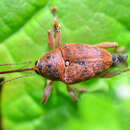Biology
provided by Arkive
Adults feed on oak (1). The females lay their eggs in acorns; the long rostrum is used to bore through the thick wall of the nut (3) with jaws located at the tip of the rostrum. When it has almost reached the centre of the nut, the egg is inserted in the hole, which subsequently heals up (4). The larvae develop inside the acorns, burrowing out when they are fully-grown in order to pupate in the soil, leaving a small hole in the wall of the acorn (2).
Conservation
provided by Arkive
Not relevant.
Description
provided by Arkive
The most striking feature of the acorn weevil is its elongated snout, known as a 'rostrum', which is longer in females than males (2). Adults have a brownish and patterned body (1). The larvae are short, and cylindrical in shape, and move by means of ridges on the underside of the body (2).
Habitat
provided by Arkive
This species is found on oak trees (2).
Range
provided by Arkive
Found mainly in southern and central parts of Europe, becoming increasingly rare further north (2). In the UK, the acorn weevil has a wide distribution in the south (1).
Status
provided by Arkive
Common and widespread (3).
Threats
provided by Arkive
This species is not threatened at present.

